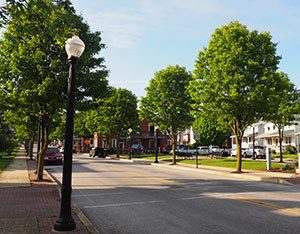Mitigating Urban Heat Islands in Chester County
Posted November 21, 2022

Have you ever wondered why it feels hotter on a city sidewalk than in a park on a hot summer day? This is because urban conditions like impervious surface and limited greenery typically absorb and radiate heat causing higher ground and air temperatures, whereas areas with more vegetation are cooler due to the shade and evapotranspiration processes of the plants.
These isolated areas of higher temperatures are known as urban heat islands, and they can have significant impacts on public health and the quality of the built environment. Through the urban heat island mitigation eTool, strategies can be put in place to help reduce these impacts.
With rising temperatures already taking place due to climate change, it's even more important for municipalities to implement strategies to mitigate urban heat islands. Strategies can include reducing impervious surfaces such as parking areas or overly wide sidewalks; providing reflective surfaces and using lighter colors; and providing shade by planting street trees and expanding urban green spaces.
In fact, planting street trees not only creates shade, but can help combat the negative effects urban heat islands have on environmental, economic, and community health. Municipalities can encourage a healthy network of trees by regulating the species, location, ownership, maintenance practices, and replacement standards for the trees through provisions in their subdivision and land development ordinance. See the street trees eTool.
Other types of urban green spaces — such as plazas and green infrastructure — can help to improve air quality, reduce stormwater runoff, promote physical and emotional health, spur economic development, and provide a sense of place, in addition to reducing the urban heat island effect. See the urban green spaces eTool.
Examples of urban heat island mitigation in Chester County include Malvern Borough's Shade Tree Commission, which oversees the selection, planting, maintenance, and removal/replacement of all street trees; as well as West Chester Borough's Tree Ordinance, which creates regulations that aim to preserve, protect, and restore the health of the Borough's existing trees and promote the planting of new trees.
The Delaware Valley Regional Planning Commission (DVRPC) provides resources that identify census tracts and block groups where temperatures are greater than the mean for the county, and where these areas overlap with vulnerable populations. These can be used as screening tools, but there is no substitute for querying residents and conducting field reconnaissance to identify specific heat island areas and impacts.
To learn more about urban heat island mitigation, including how to get started, resources, and other information, visit the eTool.
CCPC's planning eTools are intended to be user-friendly, providing a quick overview of each topic, an explanation of how it works, and considerations for addressing the topic within a community. Topic categories include agriculture; community health; economic development; environment; historic preservation; housing; land use; open space; transportation; utilities, infrastructure & energy. View the full list of eTools.

